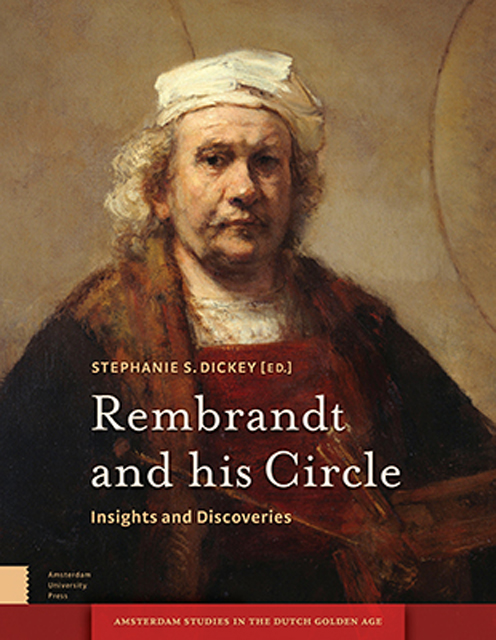Book contents
- Frontmatter
- Dedication
- Contents
- Acknowledgements
- Introduction
- 1 Rembrandt and Frans Hals Painting in the Workshop of Hendrick Uylenburgh
- 2 Rembrandt and the Germanic Style
- 3 Rembrandt and the Humanist Ideal of the Universal Painter
- 4 Curiosity and Desire: Rembrandt’s Collection as Historiographic Barometer
- 5 Painted Landscapes by Lievens and Rembrandt : The View from Seventeenth-Century Amsterdam Collections
- 6 Jan Lievens in Antwerp: Three Rediscovered Works
- 7 Gerrit Dou as a Pupil of Rembrandt
- 8 A New Painting by Jan van Noordt in Budapest
- 9 Rembrandt’s First Nude? The Recent Analysis of Susanna and the Elders from Rembrandt’s Workshop
- 10 Rembrandt’s Head of Christ: Some Technical Observations concerning Matters of Style
- 11 A Rediscovered Head of John the Baptist on a Platter from Rembrandt’s Studio
- 12 Rembrandt’s One Guilder Print: Value and Invention in ‘the most beautiful [print] that ever came from the burin of this Master’
- 13 Rembrandt, Ferdinand Bol, and Tobit: The Emergence of a Pathosträger
- 14 Biblical Iconography in the Graphic Work of Rembrandt’s Circle
- 15 Jan van Vliet and Rembrandt van Rijn: Their Collaboration Reassessed
- 16 Printmaking among Artists of the Rembrandt School
- 17 Chain Line Pattern Matching and Rembrandt’s Prints
- List of Illustrations
- Bibliography
- Index Nominum
15 - Jan van Vliet and Rembrandt van Rijn: Their Collaboration Reassessed
Published online by Cambridge University Press: 21 January 2023
- Frontmatter
- Dedication
- Contents
- Acknowledgements
- Introduction
- 1 Rembrandt and Frans Hals Painting in the Workshop of Hendrick Uylenburgh
- 2 Rembrandt and the Germanic Style
- 3 Rembrandt and the Humanist Ideal of the Universal Painter
- 4 Curiosity and Desire: Rembrandt’s Collection as Historiographic Barometer
- 5 Painted Landscapes by Lievens and Rembrandt : The View from Seventeenth-Century Amsterdam Collections
- 6 Jan Lievens in Antwerp: Three Rediscovered Works
- 7 Gerrit Dou as a Pupil of Rembrandt
- 8 A New Painting by Jan van Noordt in Budapest
- 9 Rembrandt’s First Nude? The Recent Analysis of Susanna and the Elders from Rembrandt’s Workshop
- 10 Rembrandt’s Head of Christ: Some Technical Observations concerning Matters of Style
- 11 A Rediscovered Head of John the Baptist on a Platter from Rembrandt’s Studio
- 12 Rembrandt’s One Guilder Print: Value and Invention in ‘the most beautiful [print] that ever came from the burin of this Master’
- 13 Rembrandt, Ferdinand Bol, and Tobit: The Emergence of a Pathosträger
- 14 Biblical Iconography in the Graphic Work of Rembrandt’s Circle
- 15 Jan van Vliet and Rembrandt van Rijn: Their Collaboration Reassessed
- 16 Printmaking among Artists of the Rembrandt School
- 17 Chain Line Pattern Matching and Rembrandt’s Prints
- List of Illustrations
- Bibliography
- Index Nominum
Summary
Abstract
This paper reassesses the working relationship between Jan van Vliet and Rembrandt in the context of printmaking practices in seventeenth-century Holland. Questions addressed include: Did Rembrandt really hire Van Vliet as his printmaker, like Rubens hired Vorsterman, Pontius and others? Was Van Vliet involved in some of Rembrandt's own etchings? Did Rembrandt plan a substantial series of reproductive engravings and did he make a series of oil sketches especially for that purpose?
Keywords: Rembrandt van Rijn, Jan van Vliet, printmaking, etching
Around 1631 the young painter Rembrandt van Rijn initiated an ambitious project to have his inventions reproduced in prints. He must have intended these works to help spread his fame as an artist by circulating painted compositions such as The Baptism of the Eunuch (fig. 15.1). He modelled this initiative on the engraving studio set up by his Flemish colleague Peter Paul Rubens just over a decade earlier. Like Rubens, he hired a professional printmaker to transfer the painted compositions to the copperplate. In Rembrandt's case, this was Jan van Vliet. The collaboration lasted for about five years and resulted in at least eleven etchings by Van Vliet after Rembrandt. And the two artists worked together on two large prints, The Descent from the Cross: The Second Plate (fig. 15.2) and Christ before Pilate: Large Plate (fig. 15.3), which were part of an even more ambitious project.
Apparently at the instigation of the painting dealer Hendrick Uylenburgh, Rembrandt produced eight oil sketches in preparation for a set of large-scale etched Passion scenes of which only The Descent from the Cross and Christ before Pilate were ever executed. This reconstruction of the relation of the two Leiden-based artists is now generally accepted among Rembrandt scholars. It is a reading of the available evidence, which is largely based on the assumption that Rembrandt emulated Rubens and used Van Vliet as his printmaker, just as his Flemish colleague used Lucas Vorsterman, Paul Pontius, and others. The supposed workshop practice of the Flemish artist is projected on the Rembrandt-Van Vliet situation. The scant evidence for this reconstruction will be discussed again below and alternative interpretations will be proposed.
- Type
- Chapter
- Information
- Rembrandt and his CircleInsights and Discoveries, pp. 285 - 304Publisher: Amsterdam University PressPrint publication year: 2017



